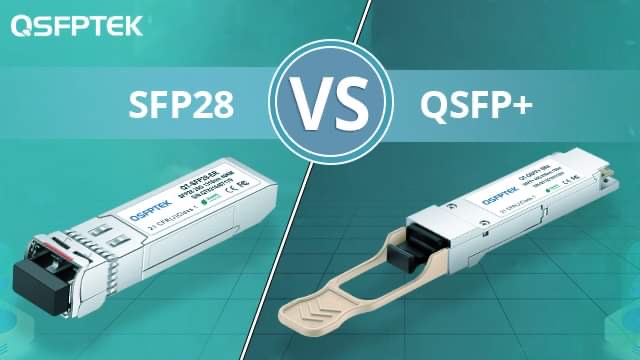
The existing 10G networks are not able to meet the communication requirements with increasing bandwidth requirements between the network devices (servers, routers, switches, etc.) today. So it is an inexorable trend to upgrade the 10G network to a higher speed. Today and the future’s data center network trends are 100G, 200G, or even 400G. However, upgrading from 10G to 100G beyond at one time requires a lot of investment. It will be a wise option to choose a transition solution for the future upgrading of 100G and beyond according to your actual networking demands. The transition solution to 100G and beyond are typically two methods, 25G SFP28 optics solution and 40G QSFP+ optics solution. What are the differences between the SFP28 solution and the QSFP+ solution? Which one is better? This article will analyze it in detail.
SFP28 vs QSFP+
SFP28 Wiki
SFP28 (Small Form-Factor Pluggable) is an incremental update from 10G SFP+, supporting 25 Gigabit Ethernet communication over one 28 Gbit/s lane. The SFP28 transceiver is Identical in mechanical dimensions to the SFP+ transceiver, and backward compatible with SFP+ ports. Besides, SFP28 has only a single lane of 28 Gbit/s, thus QSFP28 enables seamless upgrading to 100G by 4x 25 Gbit/s data lanes.
SFP28 optical transceiver modules exist supporting single-mode and multimode fiber interconnections, also supporting AOC (active optical cable) and DAC (direct attach copper) applications. SFP28 is generally applied in data center interconnects for storage, servers, switches, and 5G fronthaul today.
QSFP+ Wiki
Before the 25G Ethernet standard was issued, 40G QSFP+ was the only upgrade transition path to the higher speed of 100G networks and beyond. QSFP+ is the mainstream form factor type for the 40G Ethernet optical transceiver module. QSFP+ form factor is larter in mechanical dimensions than the SFP28 form factor, typically implemented with four transmit and four receive lanes to support 40 Gigabit transmission.
QSFP+ optical transceiver modules also exist supporting single-mode and multimode fiber interconnections, supporting AOC (active optical cable) and DAC (direct attach copper) applications. QSFP+ is mainly generally applied in the connection between data center switches to help break the bottleneck of the connection between access switches and distribution switches.
100G Upgrade Path of SFP-SFP28-QSFP28 vs SFP-QSFP-SFP28
SFP+ to SFP28 to QSFP28 (10G-25G-100G) Upgrade Path
SFP+ to SFP28 to QSFP28 upgrading path uses QSFP28 optics as intermediate transition infrastructures, enabling 2.5 times higher bandwidth connectivity than that of 10G network, but only increasing little additional cost. SFP28 solution is also good at saving optical fiber cable resources by achieving 100G network connectivity on 25G switches or servers based on 4x 25 Gbis/s lanes, no need to re-plan or change the server density per rack. And compared with 10x 10 Gbit/s transmission mode, 4x 25 Gbit/s has a lower power consumption.
SFP+ to QSFP+ to QSFP28 (10G-40G-100G) Upgrade Path
SFP+ to QSFP+ to QSFP28 upgrading path uses QSFP+ optics as intermediate transition infrastructures, supporting 40G network connectivity at 4x 10 Gbit/s parallel lanes and 100G network connectivity at 10x 10 Gbit/s parallel lanes. Since the single lane of 10G, the upgrade path is not space-efficient, and costly in cabling deployments. Besides, the underlying technology for 40G Ethernet is simply four lanes at 10G speed, which does not provide the advantages of power consumption, server rack density, and compatibility to widespread speed transition.
Why Is SFP28 Upgrading Path Better Than QSFP+?
Cost-effectiviness
Since upgrading from SFP28 to QSFP28 can be achieved by 4x 25G and SFP28 is backward compatible with existing SFP+ optics, the equipment expenditure and operating expenses can be saved by utilizing the existing cabling infrastructure. On the whole, the SFP28 upgrading path reduces the cost per gigabit significantly by fully utilizing switch port capability.
Higher Port-density
SFP28 transceiver enables network equipment manufacturers to provide 2.5 times higher bandwidth connectivity of the 10G at approximately the same power, which is much lower than 40G. Besides, the 25G SFP28 module allows higher port density configurations than the 40G QSFP module.
Backward Compatibility
The 25G SFP28 transceiver is Identical in mechanical dimensions to the SFP+ transceiver and it’s backward compatible with 10G SFP+. Besides, the majority of 25G network equipment like switches and NICs (Network Interface Cards) have higher compatibility than the 40G equipment with the 25G switches and NICs enabling backward compatibility to 10G and providing higher flexibility to manage a gradual upgrade to higher data rate servers and match port speeds.
Easy accessible to 50G/100G
25G Ethernet use single-lane 25G serializer-deserializer (SerDes) technology while 40G Ethernet consists of four lanes of 10G, thus 25G SFP28 modules can be used to build 50G Ethernet with 2x 25G configuration and 100G Ethernet with 4x 25G configuration without having to re-plan or change server per rack density.
Conclusion
The above analysis of comparing the upgrading path of SFP+ to SFP28 to QSFP28 and SFP+ to QSFP+ to QSFP28 has proved that 25G SFP28 is a more future-proof upgrade path to support 100G networks compared to 40G QSFP+. It can be predicted that the number of 25G SFP28 ports shipment will exceed the number of 10G SFP+ ports in the near future. SFP28 transceivers can be purchased today to prepare for future network upgrades based on your current network switches and infrastructure. QSFPTEK not only provides various types of high-performance and widely-compatible SFP28 transceivers and QSFP28 transceivers (Cisco, Juniper, Arista, HPE, Intel, Extreme, etc.) at best price, but also offers technical support for your data center upgrading for free.